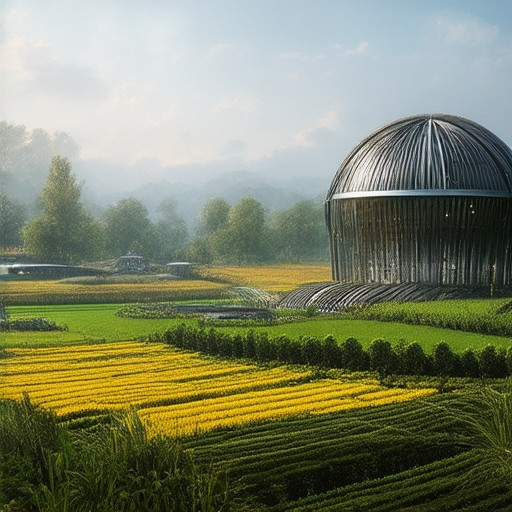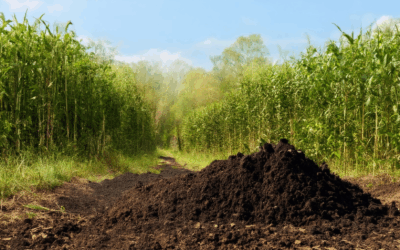Elevate Your Farming Game with Eco-Friendly Tech Innovations: A Guide to Sustainable Farming Practices
Are you ready to revolutionize your farming practices? The world is evolving, and so is the demand for sustainable, eco-conscious solutions. Today, farmers are embracing cutting-edge technologies that not only enhance productivity but also minimize environmental impact. From innovative farming techniques to groundbreaking machinery, the shift toward eco-friendly practices is no longer optional—it’s essential for the future of agriculture.
This comprehensive guide dives deep into the latest advancements in eco-conscious farming technology, offering insights, practical advice, and real-world applications. Whether you’re exploring new farming methods, comparing traditional versus eco-friendly approaches, or discovering the latest tech trends, this guide has you covered. Discover how these technologies can transform your farm, protect the environment, and ensure long-term success. Let’s embark on a journey to smarter, greener farming practices together!
Key Takeaways
– Adopt eco-friendly farming practices to reduce environmental impact and boost productivity.
– Promote biodiversity by diversifying crops and integrating pollinator-attracting plants.
– Leverage renewable energy sources like solar panels and wind turbines for sustainable farming operations.
– Sequester carbon through agroforestry and tree planting to contribute to climate mitigation efforts.
– Enhance soil health using cover cropping and crop rotation for long-term agricultural sustainability.
– Implement biological pest control methods, such as ladybugs, to reduce reliance on harmful chemicals.
– Integrate livestock systems to recycle organic waste as fertilizer and reduce external feed dependence.
– Support local markets to cut down on transportation emissions and foster community economies.
– Understand the difference between eco farming and organic farming—eco farming is a broader, more holistic approach.
– Employ sustainable techniques like crop rotation, agroforestry, and precision agriculture to maximize efficiency and minimize environmental impact.

Technologies for Sustainable Farming
Sustainable farming integrates technological innovations to enhance productivity while preserving the environment and promoting social equity. Here are some key technologies driving this movement:
- Precision Agriculture
- GPS and Satellite Imaging – Enables precise monitoring of farm locations and crop conditions.
- Soil Sensors – Measures pH levels, nutrient content, and moisture to optimize resource use.
- Crop Yield Monitoring – Uses sensors to track plant health and growth stages for timely interventions.
- Water Management
- Rainwater Harvesting Systems – Collects and stores rainwater for agricultural use.
- Drip Irrigation – Delivers water precisely to plants, minimizing waste and runoff.
- Irrigation Scheduling Software – Adjusts watering based on weather and plant needs.
- Soil and Compost Management
- Composting Systems – Manages organic waste into nutrient-rich compost, tracked via sensors.
- Cover Cropping Technologies – Software suggests optimal cover crops for soil protection.
- Livestock Integration
- Livestock Monitoring Devices – Tracks animal health and welfare, aligning with sustainability standards.
- Feed Optimization Software – Calculates feed requirements based on livestock numbers and available resources.
- Renewable Energy Systems
- Solar-Powered Irrigation Pumps – Reduces reliance on fossil fuels for water distribution.
- Biogas Generation Systems – Converts organic waste into biogas for energy production.
- Farm Management Mobile Applications
- Agri-Mobile Apps – Provides real-time updates on weather, market prices, and pest alerts.
- Field Scan Apps – Allows farmers to inspect crop conditions using satellite imagery and sensor data.
- Data Analytics and Decision Support Tools
- Yield Prediction Software – Analyzes historical data to forecast crop yields.
- Resource Optimization Platforms – Helps minimize input usage through data analysis.
- Cloud-Based Farm Data Platforms – Stores and analyzes data for actionable insights.
- Sustainable Practices Promotion
- Extension Services Online Platforms – Offers training and resources for sustainable farming practices.
- Farmer Cooperatives – Facilitates access to better markets and resources, encouraging collective action.
These technologies collectively enhance efficiency, reduce environmental impact, and promote long-term agricultural sustainability. By adopting these practices, farmers can contribute to a healthier planet and more resilient food systems.
Most Environmentally Friendly Farming Methods
The most environmentally friendly farming methods focus on sustainability, reducing ecological impact, and promoting biodiversity. Here are some key approaches:
- Organic Farming :
- Uses natural processes like composting and crop rotation to avoid synthetic chemicals.
- Reduces water contamination and soil degradation.
- Enhances biodiversity by supporting pollinators and beneficial insects.
- Agroforestry :
- Combines trees with crops and livestock to stabilize soil and improve air quality.
- Promotes carbon sequestration and enhances biodiversity.
- Ideal for regions with limited water resources.
- No-Till Farming :
- Avoids plowing to preserve soil structure and organic matter.
- Reduces erosion and minimizes fuel use.
- Enhances water retention in the soil.
- Integrated Crop-Livestock Systems (ICLS) :
- Combines crops with animals to optimize resource use.
- Manures as fertilizer and reduces reliance on external inputs.
- Supports local food production and economic viability.
- Permaculture :
- Designs systems that mimic natural ecosystems for maximum efficiency.
- Focuses on self-sufficiency and long-term food security.
- Encourages polyculture to increase biodiversity and reduce pest issues.
- Crop Rotation :
- Improves soil health by breaking pest and disease cycles.
- Reduces erosion and increases yields over time.
- Minimizes the need for synthetic fertilizers and pesticides.
By combining these methods, farmers can create holistic, eco-friendly farming systems that benefit both the environment and their operations. Each technique has unique advantages, and integrating them can lead to more sustainable and resilient agricultural practices.

What is the Newest Technology in Farming?
Farming has undergone significant transformations in recent years, driven by technological advancements aimed at increasing efficiency, sustainability, and productivity. Here are some of the most cutting-edge technologies shaping modern agriculture:
- Precision Agriculture : Tools like GPS-guided tractors and variable rate technology enable farmers to apply inputs precisely, reducing waste and environmental impact.
- Vertical Farming : Companies like Pyrolysium and others are pioneering controlled environment agriculture, using hydroponics and aeroponics to grow crops in limited spaces with reduced water usage.
- Drone Technology : Drones are now widely used for crop monitoring, weed control, and applying pesticides, offering a more efficient alternative to traditional methods.
- Autonomous Tractors and Machinery : AI-powered tractors and harvesting machines are becoming more common, capable of navigating fields and operating equipment with minimal human intervention.
- Sensors and IoT Devices : Smart sensors are being integrated into farm equipment to monitor soil conditions, weather patterns, and animal welfare, enabling real-time data analysis and decision-making.
- Biotechnology : Advances in biotechnology, such as CRISPR for seed development, are helping to create crops that are more resilient to pests, diseases, and climate change.
- Regenerative Agriculture : Practices like cover cropping, crop rotation, and agroforestry are gaining popularity for their ability to improve soil health and long-term agricultural sustainability.
These technologies not only enhance productivity but also contribute to a more sustainable and environmentally friendly future for farming. By adopting these innovations, farmers can adapt to changing conditions and meet the growing demand for food while minimizing their ecological footprint.

What is the Eco Farming System?
The eco farming system is a sustainable agricultural approach that focuses on environmentally friendly practices to enhance productivity while minimizing harm to the planet. It combines traditional farming methods with modern, eco-conscious techniques to promote biodiversity, conserve resources, and maintain long-term soil health.
The core principles of eco farming include:
- Organic Practices: Use natural fertilizers like compost and crop rotation to maintain soil fertility without synthetic chemicals.
- Sustainable Water Use: Implement water-saving techniques such as rainwater harvesting and drip irrigation systems.
- Biodiversity Promotion: Plant diverse crops and incorporate pollinator-attracting plants to support local ecosystems.
- Renewable Energy Integration: Utilize solar panels or wind turbines to power farm operations and reduce reliance on non-renewable energy.
- Carbon Sequestration: Practice agroforestry and tree planting to capture and store carbon, contributing to climate mitigation efforts.
- Local Marketing and Distribution: Sell products directly to local markets to reduce transportation emissions and support community economies.
Eco farming also emphasizes regenerative practices, such as:
- Soil Health Improvement: Incorporate cover cropping and crop rotation to rebuild soil organic matter and improve yields over time.
- Pest Control: Use biological methods like ladybugs or parasitic wasps to control pests instead of harmful chemicals.
- Integrated Livestock Systems: Keep chickens, ducks, or goats to recycle manure as fertilizer and reduce reliance on external feed sources.
By adopting these methods, eco farmers can enjoy several benefits, including increased productivity, reduced input costs, and greater resilience to climate change impacts. The eco farming system is not just about what you grow, but also about how you grow it—in harmony with nature and for the benefit of future generations.
To learn more about implementing eco farming practices, visit our main website and explore our comprehensive guides on sustainable agriculture and eco-friendly farming techniques.
Understanding the Difference Between Organic Farming and Eco Farming
Organic farming and eco farming are both approaches to agriculture that prioritize sustainability and environmental health, but they differ in their scope and practices. Below is a detailed comparison:
- Scope and Goals
- Organic Farming : Focuses on producing food without synthetic chemicals, such as pesticides and chemical fertilizers. The primary goals are to maintain health of the soil, plants, animals, and humans, along with environmental sustainability.
- Eco Farming : Encompasses a broader range of practices aimed at integrating ecological principles into farming. This includes reducing waste, preserving water resources, enhancing biodiversity, and using renewable energy sources.
- Practices and Methods
- Organic Farming : Relies on natural methods like crop rotation, composting, and biological pest control. It avoids genetically modified organisms (GMOs) and synthetic additives.
- Eco Farming : Incorporates a holistic approach, often referred to as agroecology, which considers the entire farm system. Practices may include carbon sequestration through crops, permaculture, and agroforestry.
- Sustainability Focus
- Organic Farming : Emphasizes health and safety for consumers, as well as environmental protection. It typically avoids harmful synthetic inputs and promotes fair labor practices.
- Eco Farming : Focuses on systemic sustainability, including energy efficiency, waste reduction, and biodiversity enhancement. Eco farms often aim to operate in harmony with nature and local ecosystems.
- Regulatory Standards
- Organic Farming : Must adhere to strict regulatory standards, such as those set by the U.S. Department of Agriculture (USDA) or the European Union (EU). These standards ensure organic products are free from synthetic chemicals and are produced sustainably.
- Eco Farming : While there are guidelines, eco farming is less standardized. Farms may choose to pursue certifications or operate independently based on their commitment to ecological principles.
- Examples of Practices
- Organic Farming : Composting kitchen scraps to create natural fertilizer, planting cover crops to protect soil, and using natural pest control methods like ladybugs.
- Eco Farming : Implementing renewable energy sources like solar panels, planting trees to improve soil structure, and adopting permaculture designs to maximize biodiversity and resource efficiency.
Eco farming can be seen as a broader framework that includes organic farming as one of its components. However, eco farming extends beyond organic practices by incorporating additional sustainable methods aimed at creating a more balanced and resilient agricultural system.
For more information on sustainable farming practices and eco-friendly technologies, visit our sustainable living section or explore our guide to eco farming practices .

Which is the Best Sustainable Agriculture Technique?
Sustainable agriculture encompasses a variety of practices aimed at promoting environmental health, economic profitability, and social equity. Among the many techniques available, several stand out as particularly effective and widely adopted.
- Crop Rotation: Regularly rotating crops helps maintain soil health, reduce pest populations, and minimize the need for synthetic fertilizers and pesticides. This method enhances biodiversity and ensures long-term agricultural productivity.
- Agroforestry: Integrating trees and shrubs into farming systems improves soil fertility, reduces erosion, and provides habitats for pollinators and wildlife. It also helps manage climate change impacts like drought and flood.
- Organic Farming: Organic farming relies on natural processes and inputs like compost and manure rather than synthetic chemicals. It builds healthier soils, reduces contamination risks, and supports regenerative practices that restore ecosystems.
- Conservation Tillage: Reducing tillage operations minimizes soil disturbance, preserves organic matter, and prevents erosion. This practice also sequesters carbon and improves water retention in the soil.
- Integrated Pest Management (IPM): Combining biological, chemical, and cultural methods to control pests and diseases reduces reliance on harmful pesticides. IPM promotes sustainable pest control while protecting beneficial insects and birds.
- Precision Agriculture: Using technology and data to optimize resource use, such as water and fertilizer, ensures efficient farming practices. Precision agriculture reduces waste and environmental impact while increasing yields.
These techniques collectively address key challenges in modern agriculture, making them essential for achieving long-term food security and environmental sustainability. By adopting a combination of these approaches, farmers can enhance their land’s productivity while contributing to global efforts to combat climate change and promote ecological health.
Pyrolysium advocates for these sustainable practices as part of our broader mission to promote eco-friendly living and innovative solutions for a better future. Explore our resources to learn more about implementing these techniques on your farm or property.




0 Comments